Customer service has changed. People expect quick assistance, and they don’t want to repeat themselves or wait around for answers.
Advanced AI customer service agents are helping companies respond to these expectations by stepping in where traditional tools fall short. They’re built to handle conversations in a more natural way, with the ability to adjust as the exchange unfolds. Thanks to this, businesses like yours would be able to handle higher inquiry volumes and take control of operational costs like never before.
This article takes a closer look at what AI agents are, how they support service teams, and where to begin if you’re thinking of using them.
Let’s dive right in!
Experience effortless customer service with Lyro AI Agent
What is an AI customer service agent?
An AI customer service agent is a virtual assistant trained to support real conversations with customers. It’s built to understand questions, respond accurately, and step in during key moments of the support journey. Unlike basic bots that rely on preset paths, an AI agent adapts to how people speak and what they ask for.
These AI tools are powered by natural language processing and machine learning, which help them make sense of customer messages and improve through regular use. When a situation falls outside what the AI can handle, it can smoothly involve a human agent, keeping the interaction on track.
AI agents are designed to reduce pressure on support teams while making it easier for customers to get help, whether it’s a quick question or something that needs more follow-up.
How AI agents work
AI customer service agents are designed to read messages the way people do. They recognize intent, look up relevant details, and generate a response based on what the user is trying to accomplish. Instead of reacting in a rigid way, they respond more flexibly depending on the context.
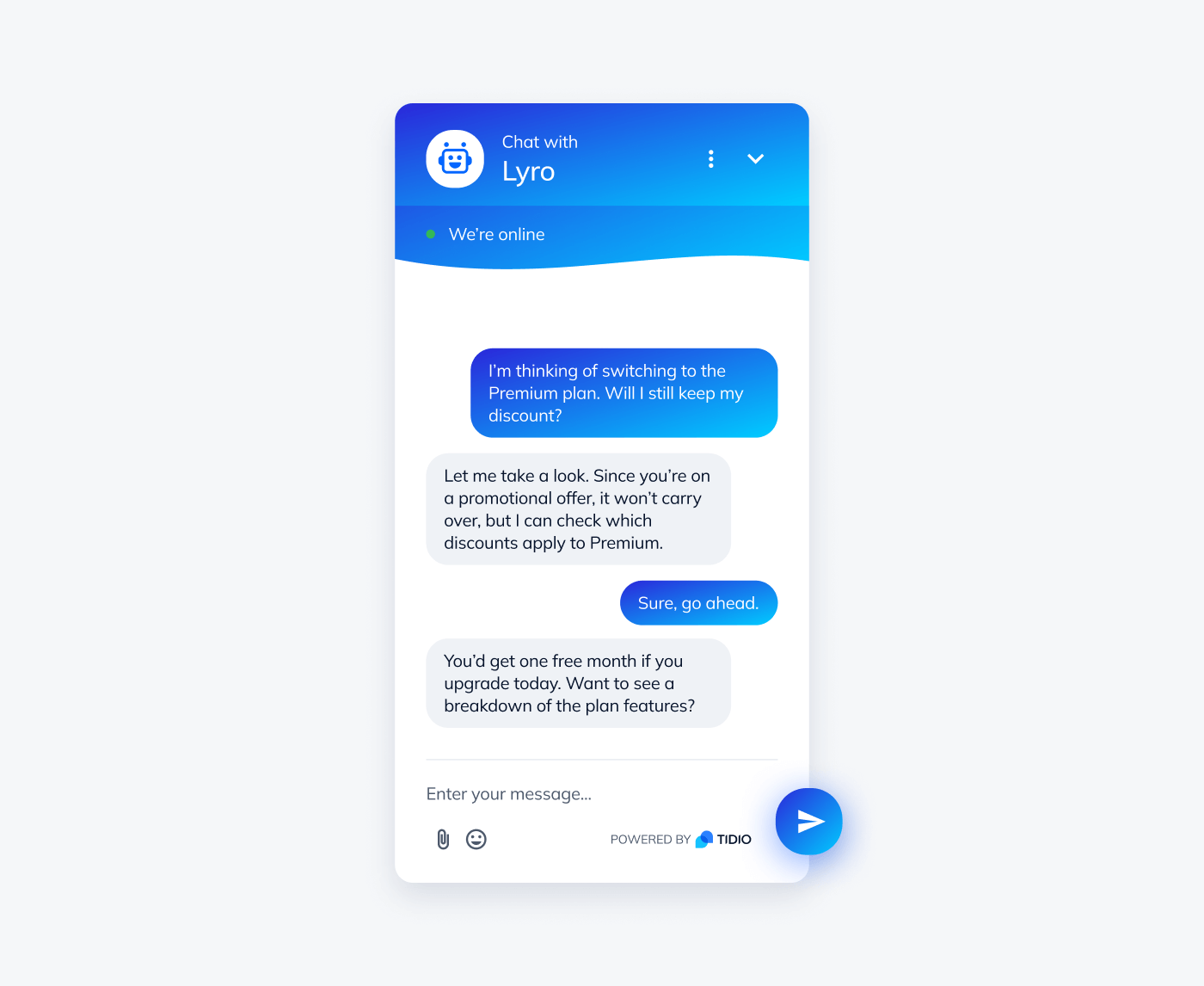
To do this well, they usually connect with tools like your CRM system or knowledge base. That way, they can reference things like a customer’s current plan or previously asked questions. If something is unclear or too complex, the agent can pass the conversation to a human without losing the thread.
What’s also great about AI customer service agents is the fact that they improve over time. With Lyro AI Agent, for instance, you can review past chats to see where answers were missing and add new information directly. This lets the system evolve with your business needs.
Read more: Find out how Suitor hit 85% customer service automation using Lyro AI Agent.
Benefits of AI agents for customer service
AI agents are built to support growing teams and customer needs in a sustainable way. By taking on everyday interactions and keeping conversations moving, they help companies improve the support experience while making operations more efficient.
Here are a few specific ways in which they add value:
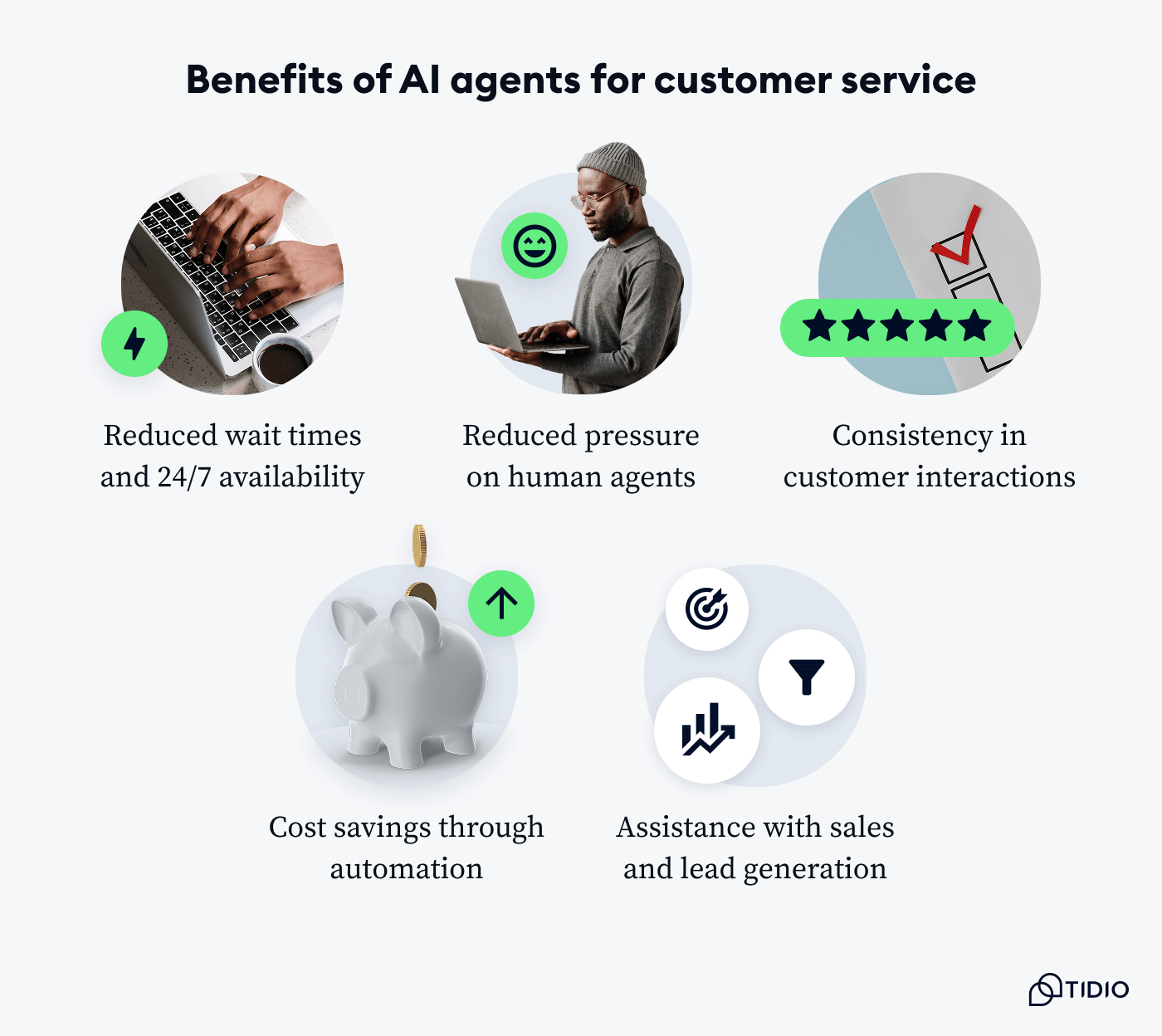
- Reduced wait times and 24/7 availability: AI agents respond right away, no matter the time of day. This keeps customers from waiting in queues and helps businesses provide consistent service across time zones. In fact, according to some reports, as many as 83% of customers seek instant resolutions.
- Reduced pressure on human agents: By handling routine tasks, AI frees up support teams to prioritize and concentrate on more complex cases. This leads to quicker resolutions and better agent productivity as a whole.
- Consistency in customer interactions: AI pulls from a single source of truth, like a knowledge base, so it gives the same answers and accurate summaries every time. This not only helps avoid miscommunication and improve customer satisfaction, but also ensures a consistent tone of voice that strengthens your brand identity.
- Cost savings through automation: Support costs can climb quickly as companies grow. AI agents help manage that by reducing the need to scale human teams at the same pace. Capgemini’s report states that AI-based customer experience can reduce operational costs by 13%.
- Assistance with sales and lead generation: AI can recommend products, answer pre-sales questions, and capture leads during live chats. It supports customers through the buying journey while increasing the chances of conversion.
Read more: Compare the best agentic AI comanies to choose the right one for your business needs. Also, discover use cases of what AI customer service can do for your business
Key use cases of AI customer service agents
AI agents are now a regular part of customer service in many industries. Aside from helping companies respond faster, they also manage repetitive requests autonomously and keep conversations moving when teams are busy. Also, instead of simply following fixed scripts, these AI systems adapt to real conversations and support a wide range of tasks.
Let’s take a look at some practical use cases of AI customer service solutions across specific industries.
Ecommerce
Customer service AI tools are especially useful in ecommerce, where customers expect quick answers about their orders and products. Whether it’s helping someone check delivery status or assisting with a return, these systems can manage high volumes of customer queries without overwhelming support teams. They also offer helpful prompts during the buying process, keeping potential clients engaged and reducing drop-off.
For example, Lyro can recognize when a shopper asks about return options and guide them through the standard return policy. If a customer mentions receiving the wrong item, Lyro can explain the next steps and offer to connect them with a support agent to resolve the issue. Since it remembers the conversation context, there’s no need for the customer to repeat themselves, which helps keep the experience smooth.
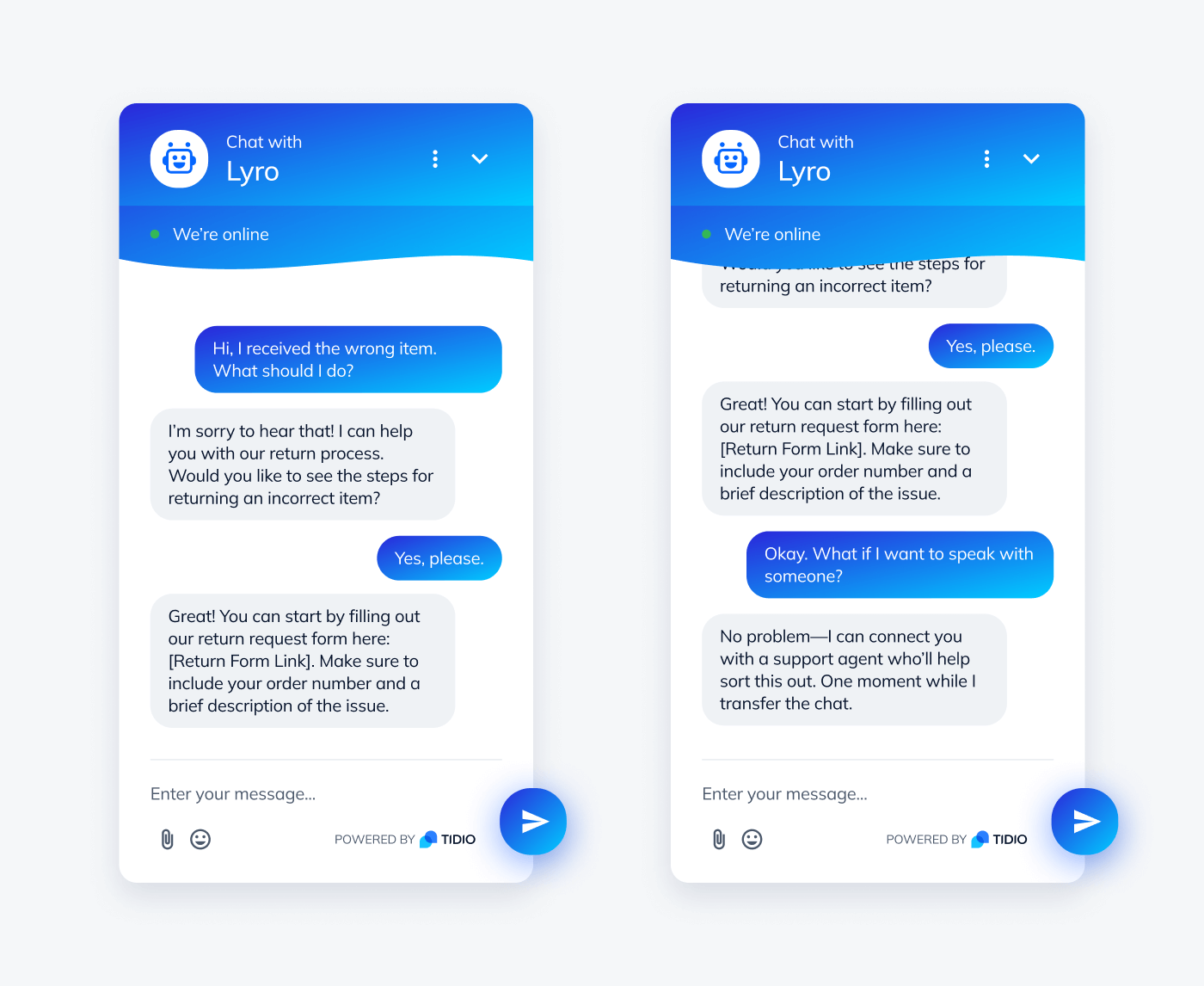
Start automating support the right way with Lyro AI
Read more: Check out the best customer service tools on the market.
Banking and fintech
AI agents for customer service are helping financial service providers stay responsive without compromising on security or accuracy. Handling anything from account-related questions to loan inquiries, these systems make it easier for customers to get help. Many companies also use AI agents to flag suspicious activity and offer real-time updates when something seems off.
N26 is a good example of a company using a customer service AI agent for fintech. They deployed Rasa’s AI assistant to automate 20% of customer service requests in weeks. This included the handling of complex issues like lost credit card reports, account security concerns, or inquiries about card expiration.
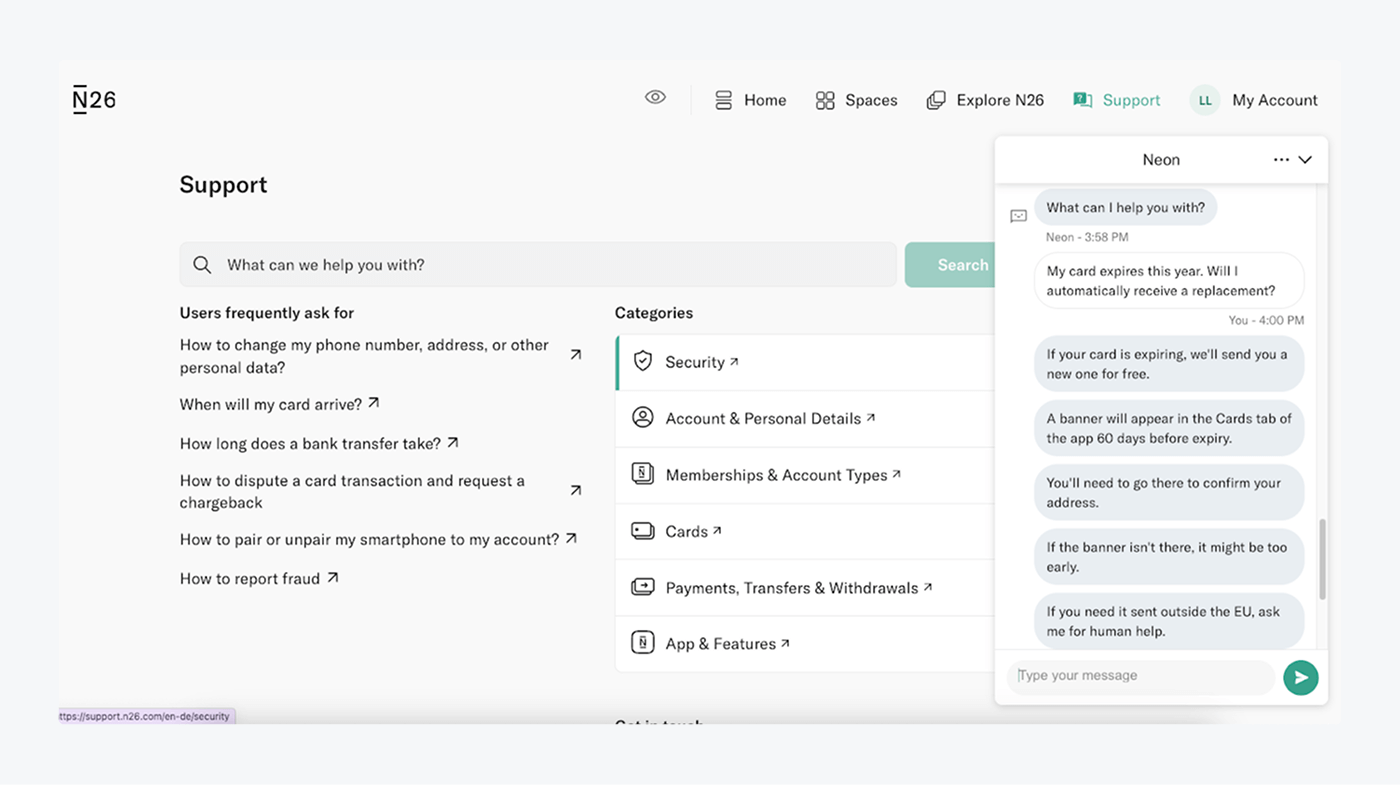
Travel & hospitality
Travelers often reach out with time-sensitive questions. This includes things like checking booking details, confirming flight times, or requesting itinerary updates. When support teams are busy, AI agents like Lyro can step in to help with basic tasks and make sure the right cases are passed to a human when needed.
For example, if a guest has a question about check-in times after a delayed flight, Lyro can provide general information about hotel policies and late check-in availability. If the request goes beyond what’s available in the system, like making a change to a reservation, Lyro can smoothly transfer the conversation to a human agent, ensuring the guest doesn’t have to start over.
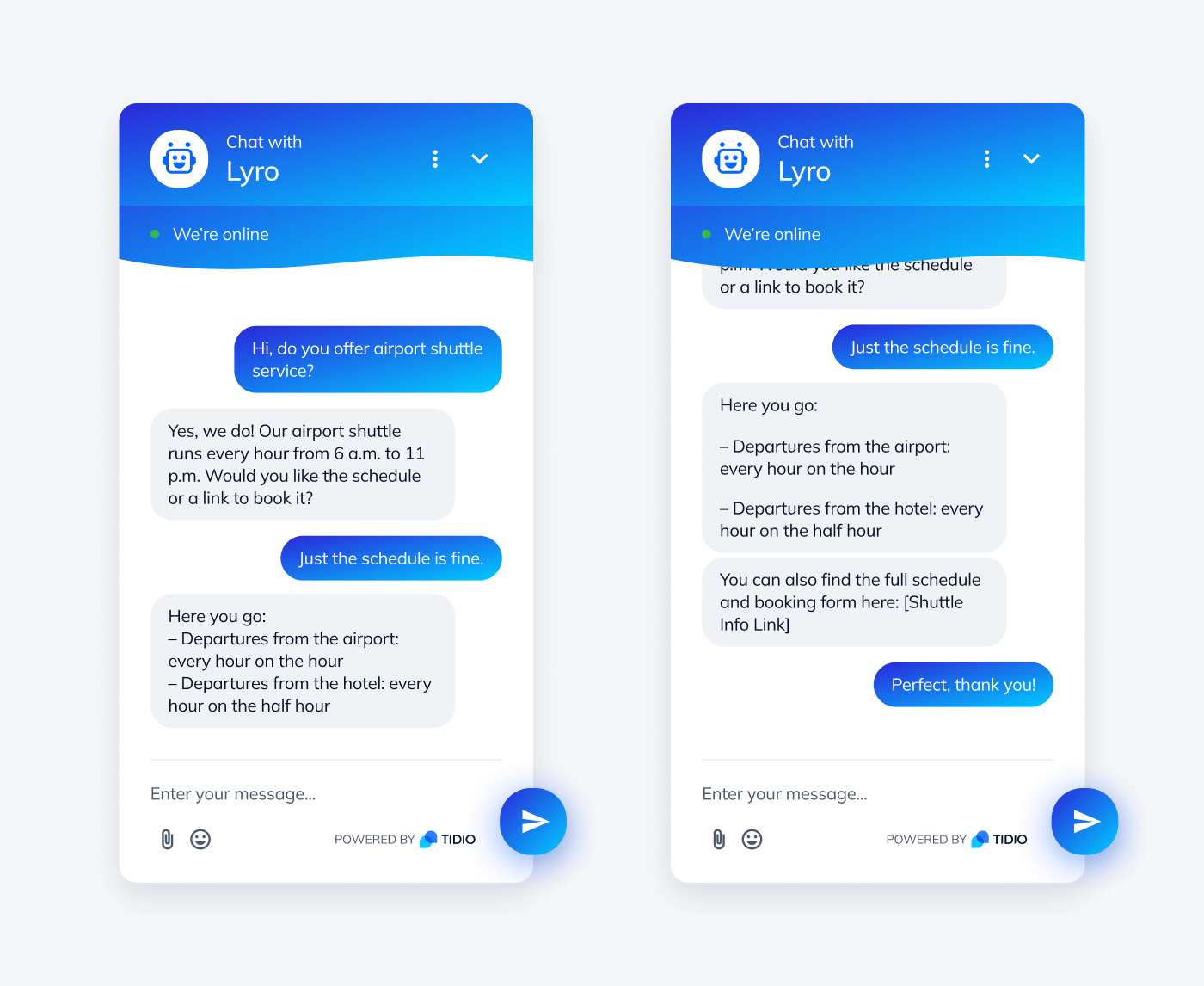
While ecommerce, fintech, and travel are common examples, AI customer service agents are now used across a wide range of industries, from healthcare and education to telecommunications and real estate. Anywhere customers need fast, accurate support, AI agents can step in to help.
Whether it’s answering insurance policy questions, guiding students through enrollment, or resolving network issues, their ability to scale and adapt makes them a valuable asset across sectors.
Read more: Find out all you should know about Tidio’s Lyro conversational AI Agent and its features.
Challenges to consider when using AI-powered customer service agents
AI agents can make support more efficient and scalable, but they also come with important trade-offs. Teams need to be thoughtful about how they implement customer service. This includes, but is not limited to, things like keeping responses accurate and making sure users feel heard. Rather than just turning on a chatbot, getting the setup right means building a system that supports both the customer and the business behind it.
Striking the right balance between automation and human support
Not every problem can—or should—be solved by an AI agent. When someone is dealing with a billing dispute or an urgent account issue, they want to talk to a real person. Relying too heavily on chatbot automation can frustrate customers if they feel stuck in a loop with no way to escalate.
A good setup includes smart routing rules that send more complex or sensitive cases to a human agent. The key is to let AI handle routine requests while making sure support teams stay accessible for everything else.
With Lyro, you can easily decide how it will handle a situation where a visitor asks to speak with a live operator or if it’s unable to answer the question. You will find the handoff settings in Configure >> Handoff tab.
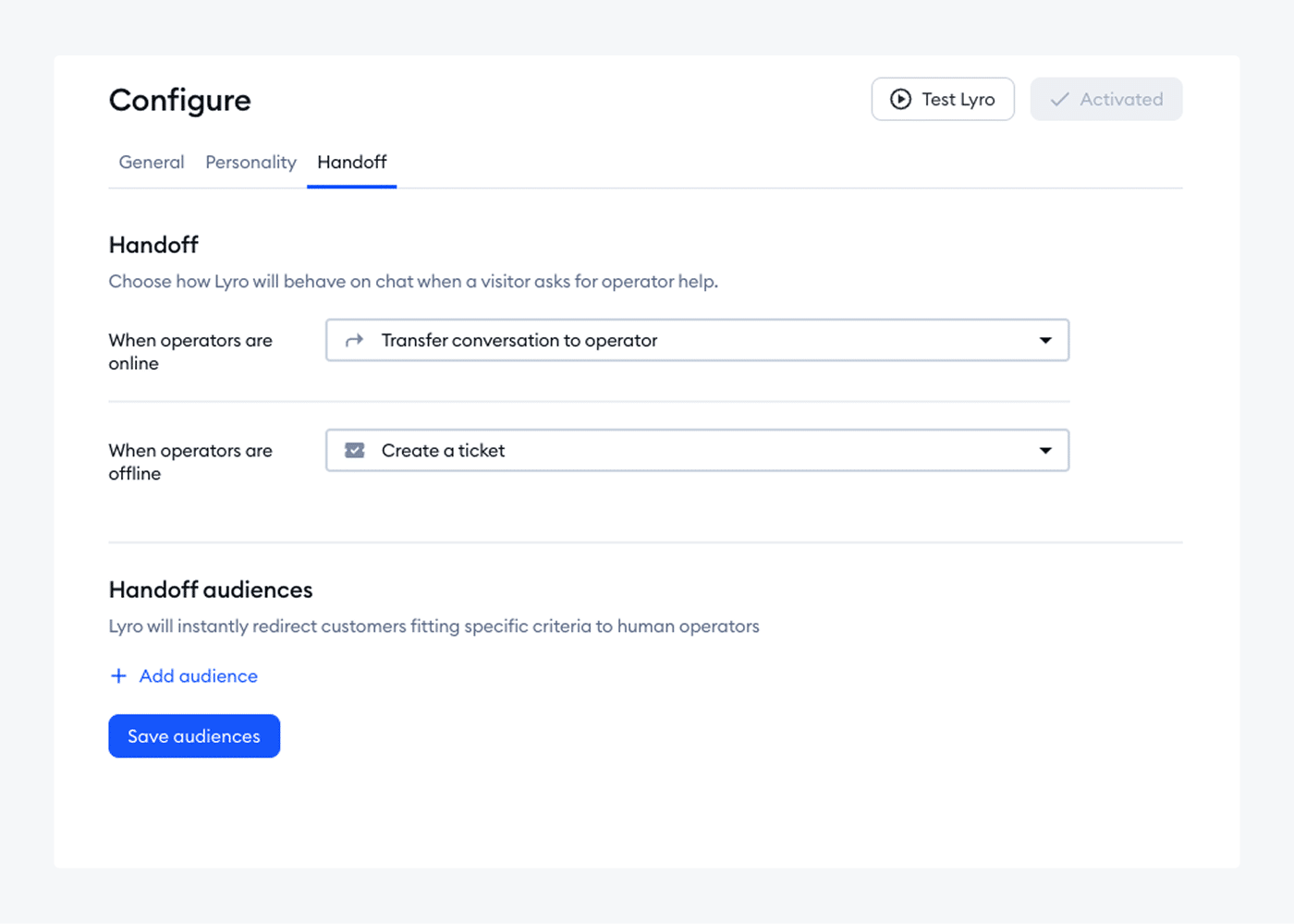
Read more: Here are the benefits and key features of chatbot automation you should know about.
Introducing AI internally without resistance
Rolling out AI support tools isn’t just a technical decision—it also affects your team. One of the most common hurdles comes from inside the company, where support agents may worry that AI will replace their roles. These concerns are valid and should be addressed openly from the start.
Rather than presenting AI as a replacement, frame it as a tool that helps reduce repetitive work and allows your team to focus on more complex, meaningful interactions. Involve agents early in the process. Show them how the system works, where it can help, and how their input is essential for training and improving it. Adjust workflows together to make space for both human and AI support. When teams feel involved, not sidelined, they’re far more likely to adopt the tool and use it well.
Dealing with AI hallucinations
One known issue in many AI systems is hallucination, which is when the AI confidently gives an answer that sounds plausible but is factually wrong. This can be especially risky in customer service, where the cost of misinformation is high.
Imagine an AI telling a customer their refund will arrive in 24 hours, when in reality the process takes a week. Even small missteps like this can break trust and create unnecessary follow-up work for your team.
The good news is that not all AI tools are equally prone to this. Lyro is designed to rely only on the content you provide, like your help center, FAQs, or uploaded documents, so it doesn’t generate answers out of thin air. It sticks to the facts you’ve given it.
Still, it’s important to review any AI-generated replies during setup, make sure your source materials are accurate and up to date, and track unanswered or flagged questions. That way, you reduce the risk of misinformation and keep customer interactions reliable.
Ensuring accuracy in responses
AI agents are only as reliable as the data they learn from. If the underlying knowledge base is outdated or unclear, the agent might give incorrect answers, or worse, mislead customers on important topics like pricing, eligibility, or delivery.
One way to reduce this risk is by connecting the agent to a dynamic source of truth. That might include your knowledge base articles, internal documentation, help desk, or CRM. Regular reviews and real-time feedback loops can also help fine-tune responses and catch issues before they affect too many users.
Security, privacy, and compliance concerns
When AI is involved in customer conversations, especially in regulated industries, security can’t be an afterthought. Companies need to make sure any solution they use handles customer data responsibly and stays aligned with local and industry-specific compliance rules.
Look for platforms that offer end-to-end encryption, access controls, and audit logs. If your business works in finance, healthcare, or ecommerce, make sure your AI vendor supports frameworks like GDPR or HIPAA.
Customer skepticism and building trust
Some users hesitate to interact with AI, especially if they’ve had poor experiences with generic bots in the past. If they’re unsure whether the system understands them or if it’s just repeating scripted replies, they may disengage before you’ve had a chance to help.
The best way to build trust is to be transparent. Make it clear when a customer is talking to an AI agent, and let them know what the agent can and can’t do. Then, back it up by delivering helpful, well-timed responses that show the AI was trained with real user needs in mind.
Read more: Learn about responsible AI customer service and check if your business uses compliant software.
How to get started with AI customer service agents
Bringing AI into your support process works best when it’s done with a clear plan. You don’t need a full system overhaul to begin. A few focused steps can help you test and roll out your AI agent quickly and in a cost-effective way.
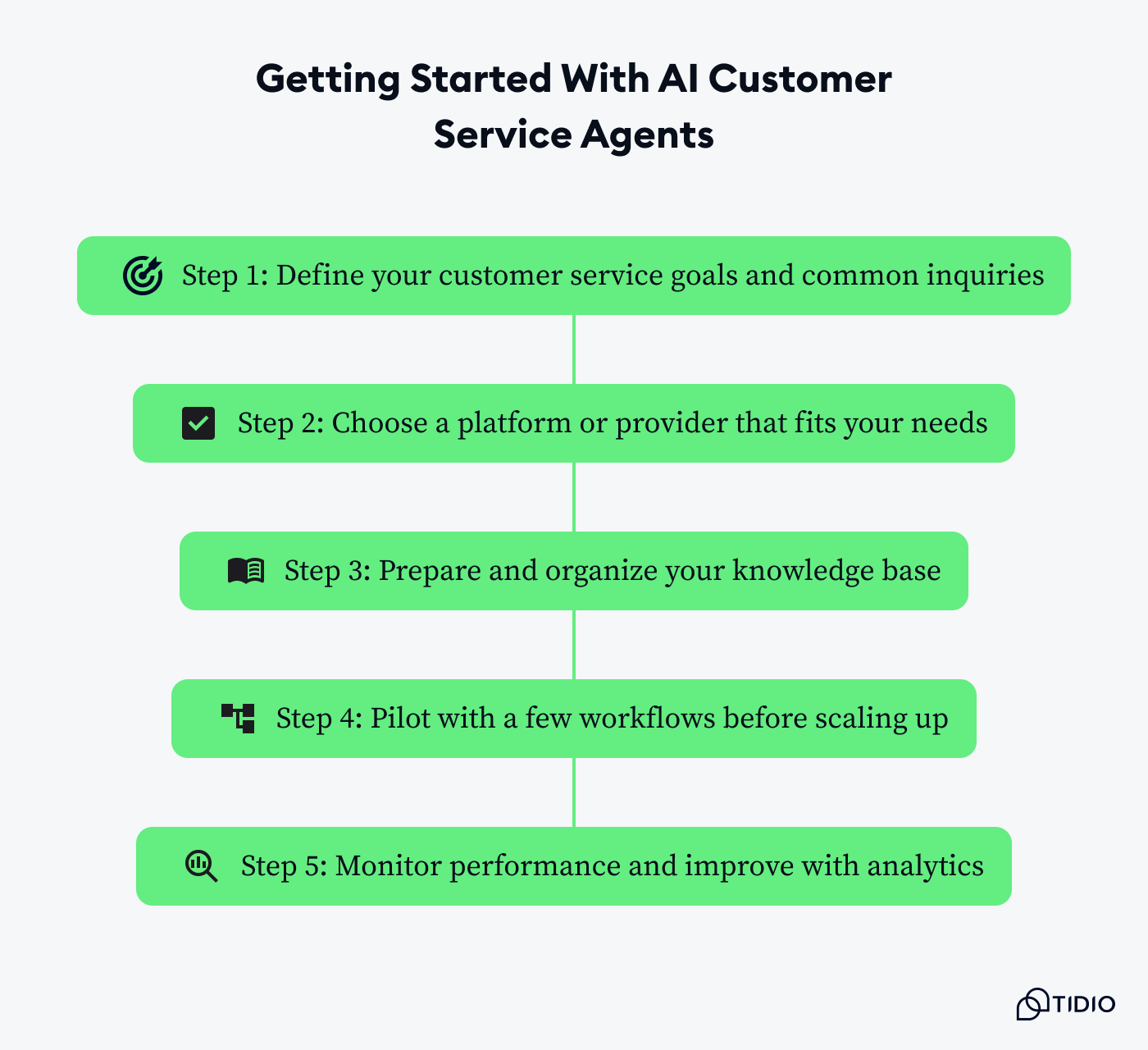
Step 1: Define your customer service goals and common inquiries
Start by identifying what you want to improve. This could be faster response times, fewer repetitive tasks for your team, or better availability outside business hours. It’s helpful to review common questions your team receives so you know where an AI agent can step in most effectively. With Lyro, you can automate high-volume support topics like order updates or account troubleshooting, making it easier to handle frequently asked questions.
Step 2: Choose a platform or provider that fits your needs
Not all AI customer service tools are built the same. Look for one that fits your industry, supports omnichannel communication, and meets your security standards. If you’re already using an AI customer service provider like Tidio, Lyro fits right in—it supports chat, email, and web conversations within the same interface, making it easy to manage everything in one place without switching tools.
Step 3: Prepare and organize your knowledge base
AI agents rely on clear, structured information. Make sure your help articles and support content are up to date. Organize the material in a way that mirrors how customers actually ask questions so the agent can retrieve useful answers more easily.
Lyro lets you upload content using your website URL, from the help center, or by importing data directly from tools like Zendesk. This makes it simple to get started with the information you already have.
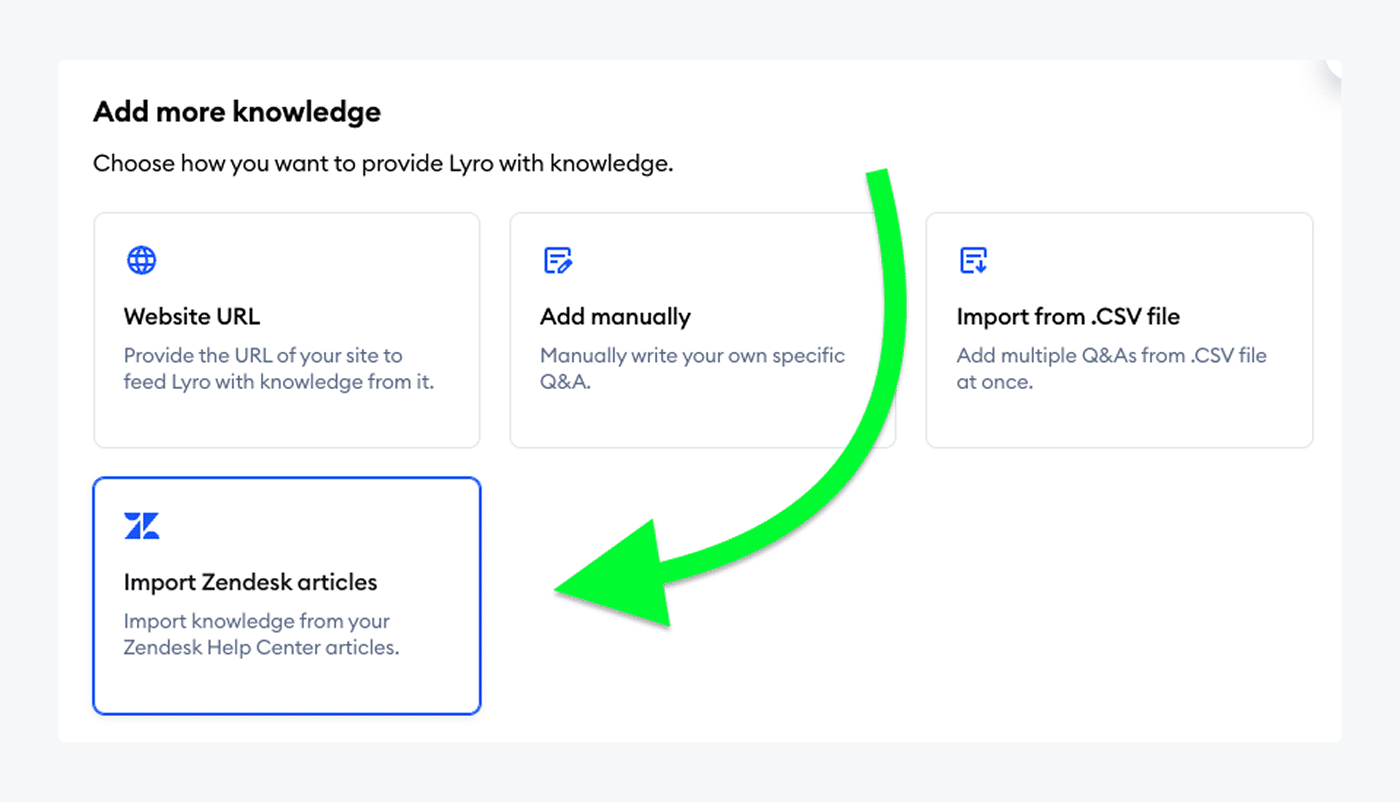
Read more: Here are the steps you need to take to create a solid knowledge base chatbot.
Step 4: Pilot with a few workflows before scaling up
You don’t need to automate everything at once. Focus on one or two support areas where customers often need assistance. This gives you room to monitor how the agent performs and make small improvements before introducing it to other parts of your support.
Lyro makes this process easy to test. You can run up to 50 conversations for free during the trial period, giving your team hands-on experience without any upfront cost. It also flags unanswered questions in real time so you can quickly spot and address any knowledge gaps.

Step 5: Monitor performance and improve with analytics
Once your AI agent is active, keep track of how it’s doing. Look at metrics like resolved conversations or how often people still ask for a human. These insights can help you update responses, add missing knowledge, and build a better customer service experience over time.
Lyro’s analytics dashboard gives you a clear view of customer service metrics like resolved conversations and resolution rates, so you can make adjustments based on real customer behavior.
Read more: If you’re ready to jump on the AI bandwagon, check out the best AI agent for customer service tools available on the market.
The future of customer service is AI-driven
AI agents are becoming more capable with every interaction. As they continue to improve, we can expect them to take on more complex tasks and respond with even greater precision. What once seemed like a tool for automating simple requests is quickly evolving into something far more dynamic.
That said, the goal isn’t to replace human support agents entirely. AI works best when it handles the bulk of routine inquiries and leaves more complex customer issues to your support team. This creates a more balanced, efficient operation where people can focus on what they do best.
If you’re looking to streamline support while keeping service quality high, Lyro is an AI solution that offers an easy way to get started. It’s fast to deploy, simple to train, and allows businesses to reduce pressure on their customer service teams while staying one step ahead of user needs.
Try Lyro for yourself and get a feel for how it can make customer service easier.
Tidio is a customer service platform that unites live chat, AI-powered chatbots, and ticketing in one place. It enables businesses to automate responses to common questions in real time and optimize their support workflows. Tidio also provides tools tailored for ecommerce and integrates seamlessly with platforms like Shopify, WordPress, and Wix.
Yes. Tidio leverages artificial intelligence to improve customer communication. Its AI agent, Lyro, understands natural language and delivers accurate, automated responses to reduce response times.
Absolutely. Tidio features both rule-based chatbots and Lyro, its AI-driven chatbot. Users can choose from ready-made templates, design their own chat flows, or let Lyro automatically handle FAQs by drawing information from their website or help content.
Tidio has flexible pricing, starting with a free plan and paid options from $29/month. The total cost varies based on features, usage, and team size. Businesses using Lyro often experience substantial time and cost savings. The average resolution rate of Lyro is 67% and the tool minimizes manual workload and speeds up responses to deliver a strong return on investment for growing support teams.

